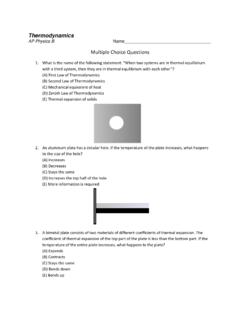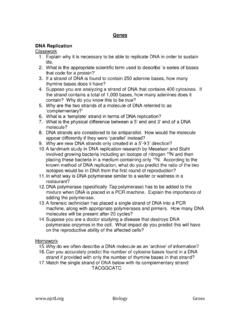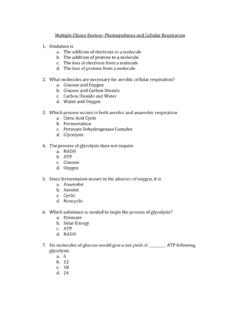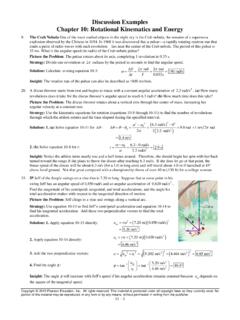Transcription of PSI Physics - Kinematics Multiple Choice Questions
1 PSI Physics - Kinematics Multiple Choice Questions 1. An object moves at a constant speed of 6 m/s. This means that the object: A. Increases its speed by 6 m/s every second B. Decreases its speed by 6 m/s every second C. Doesn t move D. Has a positive acceleration E. Moves 6 meters every second 2. A toy car moves 8 m in 4 s at the constant velocity. What is the car s velocity? A. 1 m/s B. 2 m/s C. 3 m/s D. 4 m/s E. 5 m/s 3. A train moves at a constant velocity of 50 km/h. How far will it move in h? A. 10 km B. 20 km C. 25 km D. 45 km E. 50 km 4. A boat can move at a constant velocity of 8 km/h in still water.
2 How long will it take for the boat to move 24 km? A. 2 h B. 3 h C. 4 h D. 6 h E. 8 h 5. A snapshot of three racing cars is shown on the diagram. All three cars start the race at the same time, at the same place and move along a straight track. As they approach the finish line, which car has the lowest average speed? A. Car I B. Car II C. Car III D. All three cars have the same average speed E. More information is required 6. A bicyclist moves at a constant speed of 4 m/s. How long it will take for the bicyclist to move 36 m? A. 3 s B. 6 s B. 12 s D. 9 s E.
3 18 s The graph represents the relationship between velocity and time for an object moving in a straight line. Use this graph to answer Questions 7 and 8. 7. Which of the following statements is true? A. The object speeds up B. The object slows down C. The object moves with a constant velocity D. The object stays at rest E. The object is in free fall 8. What is the velocity of the object at 5 s? A. 1 m/s B. 2 m/s C. 3 m/s D. 4 m/s E. 5 m/s 9. The graph represents the relationship between velocity and time for an object moving in a straight line. What is the traveled distance of the object at 9 s?
4 A. 10 m B. 24 m C. 36 m D. 48 m E. 56 m The following graph represents the position as a function of time for a moving object. Use this graph to answer Questions 10 and 11. 10. Which of the following is true? A. The object increases its velocity B. The object decreases its velocity C. The object s velocity stays unchanged D. The object stays at rest E. More information is required 11. What is the velocity of the object? A. 4 m/s B. 20 m/s C. 8 m/s D. 40 m/s E. 5 m/s The following graph represents the position as a function of time of a moving object. Use this graph to answer Questions 12 and 13.
5 12. What is the initial position of the object? A. 2 m B. 4 m C. 6 m D. 8 m E. 10 m 13. What is the velocity of the object? A. 2 m/s B. 4 m/s C. 6 m/s D. 8 m/s E. 10 m/s The following graph represents the position as a function of time of a moving object. Use this graph for Questions 14 and 15. 14. What is the initial position of the object? A. 2 m B. 4 m C. 6 m D. 8 m E. 10 m 15. What is the velocity of the object? A. 5 m/s B. -5 m/s C. 10 m/s D. -10 m/s E.
6 0 m/s 16. Which of the following is a vector quantity? A. Speed B. Time C. Traveled distance D. Velocity E. Area 17. Starting from the origin, a person walks 6 km east during first day, and 3 km east the next day. What is the net displacement of the person from the initial point in two days? A. 6 km, west B. 3 km, east C. 10 km, east D. 5 km, west E. 9 km, east The diagram above illustrates a person who, starting from the origin, walks 8 km east during first day, and 5 km west the next day. Use it to answer Questions 18 and 19. 18. What is the net displacement of the person from the initial point in two days?
7 A. 6 km, east B. 3 km, east C. 10 km, west D. 5 km, west E. 9 km, east 19. What is the traveled distance of the person from the initial point in two days? A. 13 km B. 3 km C. 10 km D. 5 km E. 9 km The diagram above illustrates a car that, starting from the origin, travels 4 km east and then 7 km west. Use it to answer Questions 20 and 21. 20. What is the net displacement of the car from the initial point? A. 3 km, west B. 3 km, east C. 4 km, east D. 7 km, west E. 7 km east 21. Starting from the origin, a car travels 4 km east and then 7 km west.
8 What is the traveled distance of the car from the initial point? A. 3 km B. 3 km C. 4 km D. 7 km E. 11 km 22. An object moves with a constant acceleration of 5 m/s2. Which of the following statements is true? A. The object s velocity stays the same B. The object moves 5 m each second C. The object s acceleration increases by 5 m/s2 each second D. The object s acceleration decreases by 5 m/s2 each second E. the object s velocity increases by 5 m/s each second 23. A truck travels east with an increasing velocity. Which of the following is the correct direction of the car s acceleration?
9 A. B. C. D. E. 24. A motorbike travels east and begins to slow down before a traffic light. Which of the following is the correct direction of the motorbike s acceleration? A. B. C. D. E. 25. A race car moving west begins to slow down after crossing a finish line. Which of the following is the correct direction of the car s acceleration? A. B. C.
10 D. E. The position vs. time graph of a moving object is shown to the right. Use this graph to answer Questions 26 through 30. 26. What is the average speed from 0 s to 4 s? A. m/s B. 1 m/s C. 2 m/s D. 3 m/s E. 4 m/s 27. What is the average speed from 4 s to 8 s? A. m/s B. 1 m/s C. 2 m/s D. 3 m/s E. 4 m/s 28. What is the object s position at 6 s? A. 2 m B. 1 m C. 3 m D. 7 m E. 9 m 29. What is the average acceleration from 4 s to 8 s?














